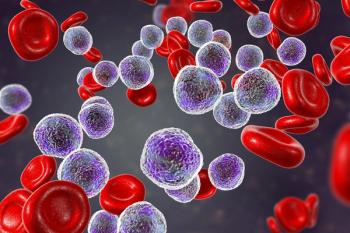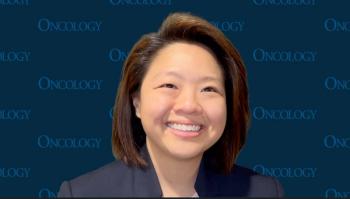
Oncology NEWS International
- Oncology NEWS International Vol 18 No 8
- Volume 18
- Issue 8
Gastric adenocarcinoma: How to choose between postoperative chemoradiation and perioperative Rx?
PHOENIX-Locoregional nodal relapse is very common in adenocarcinoma of the stomach, even after surgery, and this high failure rate has been used to justify additional therapies to improve outcomes.
ABSTRACT: Postoperative chemoradiation significantly increased survival, compared with surgery alone, in the Intergroup trial, while perioperative chemotherapy upped survival in the MAGIC trial.
PHOENIX-Locoregional nodal relapse is very common in adenocarcinoma of the stomach, even after surgery, and this high failure rate has been used to justify additional therapies to improve outcomes. But whether to use adjuvant or neoadjuvant treatment (or both) is still a matter of debate. Christopher Willett, MD, and Cornelius J. H. van de Velde, MD, PhD, discussed the respective merits of adjuvant chemoradiation and perioperative chemotherapy at the 2009 Society of Surgical Oncology meeting.
Postoperative chemoradiation
A number of clinical studies have shown a survival benefit for patients who receive postoperative chemoradiotherapy, and they compare favorably with trials of perioperative chemotherapy, said Dr. Willett, who is chair and professor of the department of radiation oncology at Duke University in Durham, N.C.
He pointed to the Intergroup 0116 trial as one of the most critical studies documenting the advantages of postoperative chemoradiotherapy. In this trial, 556 patients with resected adenocarcinoma of the stomach or gastroesophageal junction were randomly assigned to surgery alone or surgery plus postoperative chemoradiotherapy.
The median overall survival in the surgery-alone group was 27 months vs 36 months for those who received surgery and chemoradiotherapy (P = .005). Three-year survival favored adjuvant therapy (50% vs 41%) as did three-year relapse-free survival (48% vs 31%) (N Engl J Med 345:725-730, 2001).
“One of the essential take-home messages of this trial is the importance of vigorous radiation therapy quality assurance,” Dr. Willett said. The measures taken in this trial-including pretreatment review of treatment fields, dosimetry, surgery and pathology reports, and preoperative tumor imaging-resulted in only a 6.5% deviation rate from the established protocol.
Dr. Willett acknowledged that the Intergroup 0116 trial has been rightly criticized for the high rates of inadequate surgery: Most patients (54%) underwent a D0 lymph node dissection, while 36% had a D1 dissection, and 10% a D2 dissection. He added that in the Intergroup study, extent of dissection did not affect relapse-free or overall survival. Further, he said, inadequate surgery is a problem that affects the gastric oncology community as a whole, and has limited trials of perioperative chemotherapy as well.
He pointed out that while postoperative chemoradiotherapy has been shown to have high toxicity rates in clinical trials, this toxicity has decreased with modern methods of administering radiotherapy.
Dr. Willett criticized the MAGIC trial, which established in many oncologists’ minds the use of perioperative chemotherapy as a standard of care. Dr. Willett noted that the trial was limited by heterogeneous staging, including limited use of ultrasound for staging and the variable quality of both surgery and pathology (N Engl J Med 355:11-20, 2006).
“There are definitely some issues with this trial. There was a large number of surgeons-129 in all-with different skill sets. And only 42% of patients finished all the chemotherapy sessions,” he said. While it is difficult to compare the Intergroup to the MAGIC trial, Dr. Willett pointed out that two-year survival in the Intergroup trial was 58% vs 48% in the MAGIC trial.
He added that many in the oncology community are awaiting the results of the Dutch CRITICS trial (see Table on page 11), which will analyze the survival benefits of perioperative chemotherapy (three cycles before and after surgery) vs neoadjuvant chemotherapy plus adjuvant chemoradiotherapy, to help settle the ongoing debate.
Perioperative chemotherapy
Dr. van de Velde centered his argument for perioperative chemotherapy on the role this treatment has in downstaging primary tumors and eliminating metastases. Also, he said, “compliance with perioperative chemotherapy is simply much better than for postoperative treatment because it is better tolerated.” Dr. van de Velde is professor of surgery at Leiden University Medical Center in the Netherlands and president of the European Society of Surgical Oncology.
Dr. van de Velde was the Dutch coordinator for MAGIC, and he defended it based on the survival benefit shown for perioperative chemotherapy. In the trial, patients with resectable adenocarcinoma of the stomach were randomly assigned to either perioperative chemotherapy with epirubicin, cisplatin, and fluorouracil (250 patients) or surgery alone (253 patients). The treatment protocol called for three cycles of chemotherapy preoperatively and three cycles postoperatively.
The perioperative chemotherapy group had a significantly higher likelihood of progression-free and overall survival than the surgery-alone group. Five-year survival rates were 36.3% in the perioperative chemotherapy group, compared with 23% in the surgery-alone group.
By contrast, he said, postoperative chemotherapy is problematic, because it can be used only in patients who have good functional status, including good nutritional status, after surgery.
“That’s the reason MAGIC and other trials have shown complications and a lower compliance rate postoperatively,” Dr. van de Velde said. “The compliance for preoperative treatment is so much better.”
Dr. van de Velde noted that in the MAGIC trial, the resected tumors were significantly smaller and less advanced in the perioperative chemotherapy group than in the surgery-alone group. And indeed, the primary goal of treatment should be to improve treatment outcomes with surgery-a goal that’s more achievable with smaller and less advanced tumors. At the same time, it is important to improve surgical quality and to ensure that patients are not undertreated, he said.
“Perioperative chemotherapy also eliminates occult metastases at the earliest possible time and enhances the R0 resection rate,” he said. “It has become clear that perioperative chemotherapy is safe, and reduces tumor size and stage, increases R0 resection rates, and improves the chance for cure.”
Dr. van de Velde added that the CRITICS trial already has randomized 150 patients (www.critics.nl). Like Dr. Willett, he hopes that this trial will help settle the debate. Until then, he said, “perioperative chemotherapy combined with adequate surgery provides the best outcomes for patients. Postoperative chemotherapy, on the other hand, has low compliance rates and cannot compensate for poor surgery.
Articles in this issue
over 16 years ago
New Doxil-based regimens don’t fly with FDA advisorsover 16 years ago
Four steps to improve the profitability of your oncology practiceover 16 years ago
Mathematical model predicts resistance to Herceptinover 16 years ago
ASTRO issues guide on accelerated breast radiotherapyover 16 years ago
Study renews breast ca link to migrainesover 16 years ago
Sutent shows promise for brain metastases in NSCLC patientsover 16 years ago
Abraxane, carboplatin pack one-two punch in two types of lung cancerover 16 years ago
Discord prevails over pt privacy in clinical trialsover 16 years ago
Expert panel reviews strategies for nutrition and cancer careNewsletter
Stay up to date on recent advances in the multidisciplinary approach to cancer.


















































































